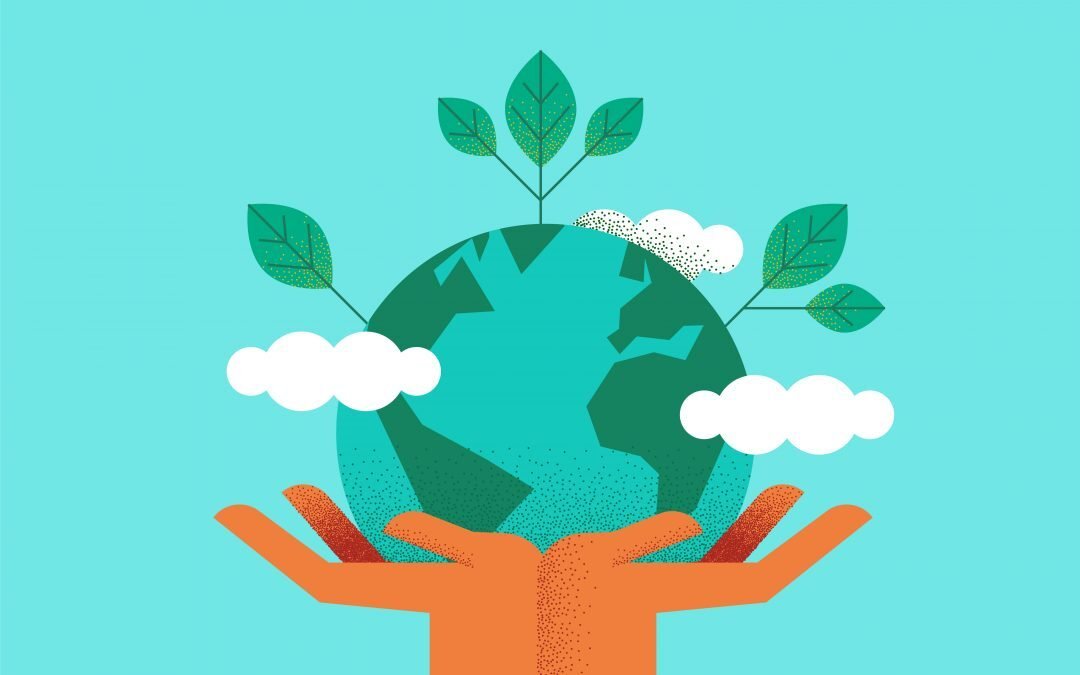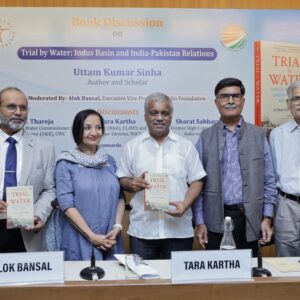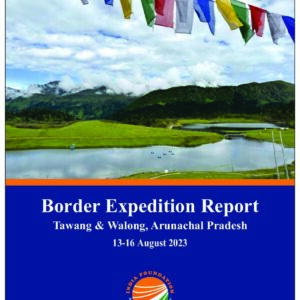Established in 1997, the Bay of Bengal Initiative for Multi-Sectoral Technical and Economic Cooperation (BIMSTEC), an inter-regional group, aimed to promote free trade, cross-border investment, tourism and technical cooperation[1]. The organisation gradually expanded its mission and now, more than two decades after its founding, BIMSTEC has a legal and institutional framework, the BIMSTEC Charter[2].
But the challenges of this century require speedier steps. One issue that needs urgent action from the BIMSTEC countries is climate change. The 5th BIMSTEC Summit Declaration of 30 March 2022 was progressive on most fronts, yet had limited mention of how to counter the effects of climate change. This is ironic, considering that all the BIMSTEC countries are vulnerable to the threats posed by climate change.
BIMSTEC contains 22% of the world’s population on 3% of its geographical area, who contribute about 4% of global GDP[3]. South Asia has the world’s highest risk of climate-induced floods, sea level rise and droughts, according to the U.N.’s most recent climate change report[4]. The IPCC report of 2022[5] also predicts significant water scarcity in countries along the Ganges and Indus rivers, and severe food shortages.
How this block tackles climate change will have implications for itself and for regions beyond its borders. A BIMSTEC Joint Working Group set up in 2021 has been tasked to prepare an Action Plan on Climate Change, a small but welcome step in the right direction. This article will evaluate climate vulnerabilities across the region, progress on cooperation and suggest ways to strengthen collaborative action.
Status Of Action on Climate Change:
Global climate change discussions focus on two broad areas: mitigation and adaptation[6]. Mitigation aims to reduce the severity of climate change at the root-cause, greenhouse gas (GHG) emissions. Reducing emissions or removing carbon from the atmosphere is crucial if the world is to meet the Paris Agreement[7]’s ambitious goal of limiting average global temperature rise to 20 C while working to further limit it to 1.50 C. Emission reduction requires a transition to green energy sources. Nullifying or sequestering carbon in forests or oceans also lowers emissions.
With 2.5 billion tonnes of annual CO2 emissions, India tops the chart in BIMSTEC, followed by Thailand (257 million tonnes) and Bangladesh (92 million tonnes)[8]. Thailand and Bhutan lead the group in per capita emissions, with 3.9 tonnes and 2.5 tonnes, respectively. Their per capita emissions are higher than India’s largely because they are more sparsely populated: India has 464 people per sq. km, Thailand and Bhutan have 137 and 20 people per sq. km.[9]. However, compared to the global average per capita emissions of 4.5 tonnes, BIMSTEC emissions are lower.
Complying with limiting the global average temperature rise to 20 C or below is expected to cost South Asia 1.3% to 2.5% of GDP annually starting in 2050. That could increase to 6% of GDP annually if emission cuts are not undertaken at all[10]. Therefore, there is an urgent need to take strong action on climate change. Country specific conditions across BIMSTEC are given below.
Bhutan, BIMSTEC’s lead country for Environment and Climate Change, is the only carbon neutral country in the world[11]. Bhutan’s forest cover removes more CO2 from the atmosphere than the country emits. However, climate change threatens vital elements of Bhutan’s growth: agriculture, hydro power, and forestry. Outburst floods from glacial lakes induced by climate change threaten the subsistence farming on which 80% of its population depends[12]. Climate change also creates soil loss, thereby degrading arable land in the long term. Flooding is expected to increase and cost as much as 4% of Bhutan’s GDP by 2030 in reduced livelihoods, destruction of agricultural land and economic output[13].
Nepal’s condition is no different. With Bhutan, it is expected to suffer higher than global average temperature rises by 2080. Increased floods, heat waves and glacial lake outbursts pose threats to Nepal’s economy as well[14]. As agriculture is responsible for over 80% of emissions in Nepal, balancing emissions reductions with food security will be a challenge. Nepal’s policies are compatible with limiting the global temperature rise to 1.50 C[15]. Turning to renewable energy sources for transportation and other uses will help to reduce the GHG footprint. Nepal plans to mandate all light vehicles be electric by 2031. However, policy hurdles need to be addressed: Nepal needs to lower import duties, incentivise domestic manufacturing, and optimise EV production costs.
Bangladesh’s geographical position makes it highly vulnerable to climate change. The world’s largest delta, most of its land is below sea level and is vulnerable to devastating floods, sea level rise and other extreme weather events[16]. Here too, agriculture is the biggest GHG emitter, followed by heat and electricity generation. and diversifying its energy sources is essential: to do so Bangladesh needs support from neighbouring countries. Shared hydroelectric power, offshore wind farms and an interconnected grid across BIMSTEC would be some of the ways its neighbours may contribute to reducing Bangladesh’s GHG emissions. The country needs about $5 billion per year until 2030 to mitigate and adapt to climate change[17], leaving it with a finance gap of USD 1.7 billion a year, a huge shortfall. The developed world will determine whether this finance gap is met. Sustainable waste management is an area where the country can reduce GHG emissions. With rapid urbanisation and limited land availability for waste disposal, this problem will be exacerbated and the need for a solution is becoming more urgent.
Although the projected average temperature rise over Sri Lanka is estimated to be slightly lower than the global average, the number of days over 350 C due to climate change will increase from 20 to 100 a year by the turn of this century[18]. This will have implications for agricultural productivity (especially rice), energy consumption and nutritional security. Flash floods and cyclones are expected to increase. Fossil fuels are the biggest contributors to Sri Lanka’s GHG emissions. Its policymakers should develop sustainable alternatives to expensive overseas fuel, especially given Sri Lanka’s ongoing economic crisis.
In India, more than 80% of the population is vulnerable to the impact of climate change[19]. Extreme weather events, cyclones, floods, heat weaves and droughts are poised to dent the country’s GDP by 12% annually by the turn of this century[20]. Other socio-economic impact ranges from migration of communities affected by climate change to the loss of life and property. India’s renewable energy plans need to be fully met if it is to significantly reduce its overall GHG emissions. India has pledged to go carbon neutral by 2070 and needs USD 10 trillion to do so[21]. Mobilisation of international climate finance will be essential for the country to meet its goal. Ground water depletion is another challenge as it is a major source of irrigation. Climate change will increase the ground water draw, further complicating projected water and food crises[22].
Increased temperatures, extreme rainfall (over 100 mm/day of precipitation) and changes to rainfall patterns threaten agricultural productivity and food security in Thailand[23]. Although the country has pledged to go carbon neutral by 2065, ambiguity surrounds its plans to achieve that feat. Details regarding the mechanisms and policy instruments to be adopted need to be spelled out before Thailand’s plan can be judged. Nevertheless, the intention to go carbon neutral exists!
Similarly, Myanmar faces hydro-meteorological threats, while most of its emissions arise from land use changes. Closer attention needs to be given to the alarming rate of loss of forest cover that is releasing trapped CO2 in the atmosphere. Between 2002-2020, Myanmar lost 4 million hectares of forest land, resulting in 2.4 Gt of GHG emissions[24]. Conversion of forest lands to other land uses needs to be strategically managed and alternatives to large-scale deforestation need to be developed.
Interstate Rivers and Biodiversity
The BIMSTEC bloc has been steadily enhancing its cooperation in the areas of inland waterway (river) transportation and shared hydroelectricity. However, BIMSTEC countries have yet to sign water-sharing agreements for several rivers. Barring Sri Lanka (due to its geographical location), all BIMSTEC countries share riverine resources. India, Bhutan, and Bangladesh share the watershed of the Ganges, Brahmaputra, and Meghna. Myanmar and Thailand share important rivers with the Salween forming a natural barrier between them.
Rivers are important to the livelihoods of fishing communities and contribute to the region’s food security. However, the majority of river-sharing arrangements amongst these countries have yet to be formalised or even formally discussed. India and Nepal haven’t signed any agreements since the Mahankali water-sharing agreement of 1985. India and Bangladesh have yet to reach a Teesta water sharing treaty. Use of the Salween continues to be a contentious issue between Thailand and Myanmar.
Although river-sharing may appear to be a bilateral issue, ambiguity on water allocation may lead a country to take unilateral decisions, resulting in regional conflicts. With climate change-induced droughts and ground water depletion, countries need to find more water for their populations. This will create competing claims over river water. To prevent erosion of trust and camaraderie, it is in the interest of BIMSTEC to proactively deal with emerging threats.
This region is rich in biodiversity: BIMSTEC countries are home to four of the world’s major biodiversity hotspots.: the Western Ghats and Sri-Lanka, Indo-Burma, the Himalayas and Sunderland. A hotspot must satisfy two important criteria[25]
- Host at least 1,500 species of vascular plants that are not found anywhere else on the planet (endemic species.)
- Contain 30% or less of its original vegetation, meaning it is threatened by human activity.
People benefit from hotspots. They provide water, livelihoods to indigenous communities, timber and non-timber forest products, and are significant for building resilience against climate vulnerabilities. Climate change and pressure from people have put these hotspots at risk. Illegal wildlife trade, poaching, loss of vegetation and biodiversity are some of the key threats. Remedying these requires collective action by member countries across borders.
Figure 2. Biodiversity hotspots of BIMSTEC. Source: https://www.tropicalconservationfund.org/biodiversityhotspots.html
Recommendations
Climate change is a shared problem that all countries face and the BIMSTEC countries are no exception. BIMSTEC must urgently work to reduce climate vulnerabilities, mitigate emissions and adapt to changing climate, to contribute to sustainable development in the region. The following is recommended:
Advocate forClimate Finance Flows from the Developed World: Climate finance is vital to enable BIMSTEC countries to deal with the crisis. Climate finance needs have been assessed for India[26] and Bangladesh[27] but to advocate effectively for ways to meet climate finance requirements BIMSTEC needs to determine the total amount of climate finance required by each country, as well as for sub-regional requirements. While country-driven approaches for the delivery of climate finance are useful, a regional assessment will enable the block to demand financial resources from the developed world. Countries working together under regional or contextual groups can better influence global discussions to secure their interests.
A Shared Framework on Climate Change Response: A framework needs to be developed that provides guidance to collectively deal with crises from climate-induced events. This will help preparations and the humanitarian response before, during and after an extreme weather event.
Financial Resource Pool: Within BIMSTEC a financial resource pool for a range of responses to climate change must be developed. A line of credit or other practical mechanism can be developed to support activities such as renewable energy promotion, sustainable technology acquisition, afforestation, climate smart agriculture, disaster risk reduction and more. Coupled with the framework on climate change, this financial resource pool will ensure resources are available when a country needs them, rather than forcing governments to solicit financial support after a calamity has struck.
Achieving Net-Zero Through Regional Collaboration: As BIMSTEC economies grow, their GHG and environmental footprint will also increase. Although most have plans to become ‘net-zero,’ they will need to obtain climate finance, technological support and capacity building to be successful. The international commitments on mobilization of climate finance agreed at Paris ($100 billion replenishable annually) have not yet been fully met or disbursed. The global response to the war in Ukraine might create competing claims on financial resources from the developed world. It is important for countries like India, with its extant ability and know how, to produce climate resilient technology and build capacity to support its regional neighbours.
Weather Forecasting Capacities: Improvements can be made to regional weather forecasting and emergency response capacities. India pledging to reactivate the BIMSTEC Centre for Weather and Climate will boost the region’s weather forecast capabilities[28]. Two multi-agency Disaster Management Exercises have been carried out that will strengthen shared emergency responses. India may take a lead in developing and launching a dedicated satellite for the BIMSTEC region to further augment regional weather monitoring capacity.
One Sun, One World, One Grid: While the renewable energy gap closes, the region’s energy supply needs to be secure. BIMSTEC’s equatorial and tropical countries have sunshine most of the year; their geography allows them to harness solar energy for extensive periods of time. Expansion of the green energy grid One Sun, One World, One Grid (OSOWOG) in the region can provide renewable energy and energy security. BIMSTEC’s Grid Interconnection Coordination Committee plans to develop a green grid as well as the policy framework for trade, exchange of electricity and a tariff mechanism[29], India can take the lead in supporting the development of a BIMSTEC green grid that can become a sub-set of the South-East Asian OSOWOG. India already has plans to connect Sri Lanka with an interconnected grid and is working with its Southeast Asian neighbours on OSOWOG[30]. Harnessing offshore wind energy over the Bay of Bengal and distributing it through the grid is a good way to increase the share of renewables in the energy basket.
Biodiversity And Natural Resource Conservation: The area is teeming with biodiversity and is home to many indigenous species of flora and fauna. Given the geographical contiguity of the block’s countries, a shared conservation initiative is a natural group effort, with joint initiatives essential to safeguard natural resources, prevent illegal trade and hunting of endangered animals. India’s success in participatory conservation methods such as Joint Forest Management, can provide a template for the region. Participatory collaboration can be force-multipliers for wildlife surveillance, community-driven conservation and to secure livelihoods of communities that depend on biodiversity. A shared mechanism, such as a group of environment ministers, can oversee conservation efforts across BIMSTEC.
Formalizing Water-Sharing Agreements: Although BIMSTEC focuses on the Bay of Bengal, the rivers traversing the region are crucial for freshwater supply to the bay, the livelihood of communities and economic activities. The bloc must engage with member countries to settle water-sharing agreements on trans-boundary rivers. River-sharing agreements between India and Bangladesh for the Teesta, and between Thailand, Myanmar and China for the Salween must be concluded. Parties need to abide by agreements in existing river settlements as trust between countries is indispensable for the success of BIMSTEC. Given that climate change will exacerbate the regional water crisis, it is vital for BIMSTEC to incorporate the terms ‘river’ and/ or ‘water’ in its charter and to develop a cooperation initiative on water.
Conclusion
BIMSTEC is an important initiative for collective action on the region’s most challenging issues. Climate change cannot be ignored. Its impact needs to be carefully evaluated, vulnerabilities must be identified, and collective action plans developed to reduce dangers. The lead country on Environment and Climate Change, Bhutan, must act urgently and guide the working group in preparation for a road map for BIMSTEC. This bloc must focus on being ‘atmanirbhar’ to combat climate change as the threats it faces are unique. Solutions are available in the region. If BIMSTEC countries take on climate action together, they will strengthen the group and act as a replicable model for regional cooperation.
Author Brief Bio: Damodar Pujari is Fellow, Climate Change, Gateway House, Mumbai
References:
[1] Bangkok Declaration Document, Government of Nepal: to promote free trade within the region, increase cross-border investment and tourism and to promote technical cooperation
[2]https://drive.google.com/file/d/1imTXMnsLg3ostI-kN8E5L6CeRyMWrGhh/view
[3]https://databank.worldbank.org/source/world-development-indicators
[4]https://www.ipcc.ch/report/ar6/wg2/downloads/outreach/IPCC_AR6_WGII_FactSheet_Asia.pdf
[5]https://www.ipcc.ch/report/ar6/wg2/downloads/outreach/IPCC_AR6_WGII_FactSheet_Asia.pdf
[6]https://www.eea.europa.eu/help/faq/what-is-the-difference-between#:~:text=In%20essence%2C%20adaptation%20can%20be,(GHG)%20into%20the%20atmosphere.
[7]https://unfccc.int/sites/default/files/english_paris_agreement.pdf
[8]https://ourworldindata.org/co2/country/bhutan?country=BTN~BGD~MMR~THA~NPL~LKA~IND
[9] Our world in data and Global Carbon Project: https://ourworldindata.org/co2/country/bhutan?country=BTN~BGD~MMR~THA~NPL~LKA~IND
[10] Assessing the costs of climate change and adaptation in South Asia. Mandaluyong City, Philippines: Asian Development Bank, 2014.: https://www.preventionweb.net/files/38999_assessingcostsclimatechangeandadapt.pdf
[11] Hindustan Times report: https://www.indiatimes.com/explainers/news/negative-emission-of-carbon-552521.html#:~:text=Bhutan%20do%20it%3F-,The%20Kingdom%20of%20Bhutan%20is%20the%20only%20country%20in%20the,eventually%20creates%20a%20carbon%20sink.
[12] Royal Government of Bhutan (RGB] (2006). National Adaptation Programme of Action. Retrieved from http://unfccc.int/resource/docs/napa/btn01.pdf
[13] Bhutan’s Climate Risk Profile by Asian Development Bank: https://www.adb.org/sites/default/files/publication/722636/climate-risk-country-profile-bhutan.pdf
[14] Nepal’s Climate Risk Profile by ADB: https://www.adb.org/sites/default/files/publication/677231/climate-risk-country-profile-nepal.pdf
[15]https://climateactiontracker.org/countries/nepal/
[16] Bangladesh’s Climate and Disaster Risk Atlas by ADB: https://www.adb.org/sites/default/files/publication/760781/bangladesh-climate-disaster-risk-atlas-volume2-cover-pgxxiv.pdf
[17]https://www.opml.co.uk/blog/combat-climate-change-bangladesh-example-to-follow
[18] Sri Lanka’s Climate Risk Profile by ADB: https://www.adb.org/sites/default/files/publication/653586/climate-risk-country-profile-sri-lanka.pdf
[19] Climate Change Vulnerability Index of India, CEEW: https://www.ceew.in/publications/mapping-climate-change-vulnerability-index-of-india-a-district-level-assessment
[20] The costs of climate change in India by Overseas Development Institute: https://odi.org/en/publications/the-costs-of-climate-change-in-india-a-review-of-the-climate-related-risks-facing-india-and-their-economic-and-social-costs/
[21] World Economic Forum: https://www.weforum.org/agenda/2022/01/green-finance-bolster-india-transition-net-zero/#:~:text=The%20goal%2C%20according%20to%20the,%2C%20industrial%2C%20and%20transport%20sectors.
[22]https://edition.cnn.com/2021/02/24/asia/india-groundwater-study-intl-hnk-scn/index.html
[23] Thailand climate vulnerability profile: https://www.iucn.org/sites/dev/files/content/documents/thailand_country_profile_june2014_press.pdf
[24]https://tinyurl.com/2p8dpnzv
[25] Conservation Priorities: https://www.conservation.org/priorities/biodiversity-hotspots#:~:text=To%20qualify%20as%20a%20biodiversity,in%20other%20words%2C%20is%20irreplaceable.
[26]https://www.theclimategroup.org/our-work/news/financing-climate-action-india-priorities-and-reflections-cop26-indian-states
[27]https://unfccc.int/sites/default/files/resource/Climate_en_com.pdf
[28]https://www.business-standard.com/article/economy-policy/india-to-lead-security-pillar-of-bimstec-pm-pitches-for-regional-security-122033001342_1.html
[29] BIMSTEC Event Update: https://bimstec.org/?event=bimstec-grid-interconnection-coordination-committee-deliberates-on-how-to-undertake-the-bimstec-grid-interconnection-master-plan-study-bgimps
[30] Financial Express: https://www.ris.org.in/bimstec/bookspdf/FE-29-05-2020-One%20Sun%20One%20World%20One_Grid.pdf




